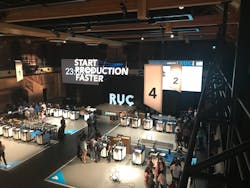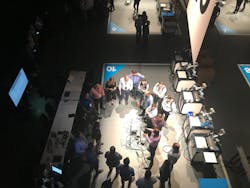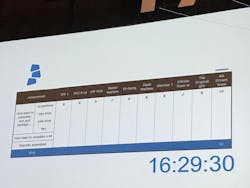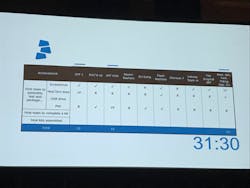With an increasing skills gap, robotic manufacturers are making them easier to use. Each year a few companies invested in starting production faster, meet in Quebec City for a few days of networking, educational presentations, and a 24-hour robotic challenge. Robotiq's and Universal Robot's (UR) Pendant Armor challenge a group of teams with limited or no experience to make a fully autonomous production line in 24 hours.
Last year, 10 teams assembled pumps using UR arms with Robotiq’s grippers. The companies involved learned a lot from watching firsthand the hang-ups that the teams ran into. I assumed this year the technology would be even easier to use, which would inevitably mean an even more ambitious challenge for RUC 2018. After returning from the event, it looks like I was right.
Upgrading the Robotiq Software and Challenge
RUC 2018’s 24-hour challenge was to assemble a swag package that consists of…
- Screwdriver
- Hex/Torque Keys
- Blank disassembled USB flash drive
- Disassembled pen
With the slogan of the event being “Start Production Faster,” there was a 10-point bonus for the team that was first to complete each task and complete the first whole kit. Then teams would receive one additional point for each kit produced within the 24-hour period.
The first team on the board was team 10, after completing the screwdriver.
As the attendees started, stacks of parts laid around the room. Anyone trying to complete this challenge would have to master the products and successfully set up an entire production line within a day. Despite the feedback and vision from the gripper, I saw a few crushed pen shafts (though not as many as I expected to see).
Also, robotic arms were scattering USB parts and knocking them off the tables. Grippers tried to precisely place the USB flash drive into a machine to load on the Robotiq promotional package, but instead rammed into the side of the device until the force torque sensor stopped the UR arm.
Eventually it looked like the risk of failure paid off. After only a few hours, robots were already moving and gripping. However, in the first few hours no points had been awarded. Keep in mind that many of the people at the event had limited or no experience with this equipment, and they were given no instruction. Each team was given an expert from Robotiq, but they were instructed not to intervene unless necessary.
While no one was completing tasks, they were learning rapidly: finding features like linear and spiral search to align parts, and figuring out how to use the camera to guide the arm. There was even a feature called Active Guide, where you guide the gripper with your hand. The movement was recorded and repeated—no G-coding, no point-to-point…just grab-and-go. These features allow anyone to program a robot. Companies want their products to be so user-friendly that anyone can get a robot up and running quickly and focus on more ambitious tasks.
Tasks have to be completed and witnessed by a referee to run for three cycles without error in order to gain points.
After seven-and-a-half hours, only three teams had completed a single task. No one looked tired or frustrated, though; each team was making progress. This is what makes Robotiq different from many other companies. If a team fails the challenge, Robotiq still wins.
They just taught dozens of people how to use its product and become comfortable with it. Any issues that might leave anyone feeling like they failed are taken as first-hand real-life feedback on how to improve the product. And if anyone was still upset, the event has a lot of food and drinks (productivity did slow after the gin station opened, however).
All work and no play: While many people were up all night working on the challenge, some teams took time off to hack into one of the monitors to watch a football game.
Many contestants stayed up all night, but with 30 minutes left I had to leave to catch my flight. Almost every team completed one or two tasks, and one team completed three. Everyone left with more connections and knowledge than they came with. I also like that the challenge creates a production line to assemble Robotiq’s swag bags. While the challenge was unable to be beaten, I wonder what the challenge will be next year. If invited back, I have asked to be placed on a team, so I can cover the event from a more hands-on prospective.
This event gives a view into many trends in automation. First, I heard over and over again that there is no will to replace people; the problem is finding people with needed skills. But finding automation equipment to help solve this problem tend to cause other issues: Current employees may not be robotics experts or programmers, or understand the best applications to automate (or the ones that will generate the most ROI). Having flexible, easy-to-use automated equipment will help companies automate processes quickly and easily without replacing people; instead it will increase production with their current employees. This then leads to the company growing, and again, needing skilled people for this expansion.
It might be a good problem to have, but more and more companies are trying to circumnavigate the skill gap only to find that if it works, they inevitably run into the same problem. The skill gap is one of the biggest issues hindering company growth. If we can’t find a more sustainable solution to the skills gap, U.S. companies’ problems will turn into a U.S. market problem.
Companies like the ones at RUC are trying. For its part, UR has started the UR Academy. This 87-minute online training course is free, and part of another trend we’ve been seeing in the last few years. Rockwell, Eaton, Festo, Fanuc, and others have all started their own types of training to help educate people to address this problem.




